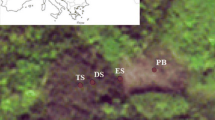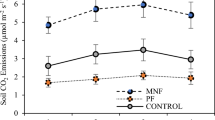Abstract
Soil respiration is the second largest CO2-exchange process between terrestrial ecosystems and the atmosphere. Yet, high-quality experimental data are still in demand. During the vegetation period of 2013 we measured soil and ecosystem respiration with a closed dynamic flux chamber at six Saxon ICP-Forests Level II monitoring sites, representative for Central Europe. Each site comprises a closed canopy (UC) and an open field (OF) plot. Apart from CO2 fluxes, meteorological parameters were recorded, assuring that the chosen measurement period was representative for longer time frames. Additional soil samples delivered current chemical conditions. Carbon dioxide fluxes at the open field plots were 30–250 % higher than under canopy—due to different plant cover. Under canopy, 2.7–5.8 µmol CO2 m−2 s−1 were determined (median 3.5 µmol CO2 m−2 s−1), while the open field showed a range of 3.2–15.5 µmol CO2 m−2 s−1 (median 7.6 µmol CO2 m−2 s−1). The key drivers for soil metabolism, soil temperature, humidity and nutrient budget, showed distinct plot and site differences. Surmising that the determined fluxes are representative for Saxony and its temperate forests, and calculating with winter half year data from the literature, it can be deduced that 3.85 Mt C of carbon would be released annually from Saxon forest soils.


Similar content being viewed by others
References
Bahn M, Kutsch WL, Heinemeyer A, Janssens IA (2012) Appendix: towards a standardized protocol for the measurement of soil CO2 efflux. In: Kutsch WL, Bahn M, Heinemeyer A (eds) Soil carbon dynamics. An integrated methodology. Cambridge University Press, Cambridge, pp 272–281
Batjes NH (2014) Total carbon and nitrogen in the soils of the world. Eur J Soil Sci 65(1):4–21
Beerling DJ, Lomax BH, Royer DL, Upchurch GR Jr, Kump LR (2006) An atmospheric pCO2 reconstruction across the Cretaceous-Tertiary boundary from leaf megafossils. PNAS 99(12):7836–7840
Bond-Lamberty B, Thompson A (2010) A global database of soil respiration data. Biogeosciences 7:1915–1926
Brumme R, Beese F (1992) Effects of liming and nitrogen fertilization on emissions of CO2 and N2O from a temperate forest. J Geophys Res 97:12851–12858
Cools N, Vesterdal L, De Vos B, Vanguelova E, Hansen K (2014) Tree species is the major factor explaining C:N ratios in European forest soils. Forest Ecol Manag 311:3–16
Dalal RC, Allen DE (2008) Greenhouse gas fluxes from natural ecosystems. Turner Review 18. Aust J Bot 56:369
FAO (2014) Global Land Cover-SHARE of year 2014—Beta-Release 1.0. http://www.glcn.org/databases/lc_glcshare_en.jsp. Accessed 23 Feb 2015
Hirano T (2005) Seasonal and diurnal variations in topsoil and subsoil respiration under snowpack in a temperate deciduous forest. Global Biogeochem Cycles 19: GB2011. doi:10.1029/2004GB002259
Hubbard RM, Ryan MG, Elder K, Rhoades CC (2005) Seasonal patterns in soil surface CO2 flux under snow cover in 50 and 300 year old subalpine forests. Biogeochem 73:93–107
ICP-Forests (2011) http://icp-forests.net/page/level-ii. Accessed 23 Feb 2015
IPCC (2013) Climate change 2013: the physical science basis. Contribution of working group I to the Fifth Assessment Report of the Intergovernmental Panel on climate change [Stocker TF, Qin D, Plattner GK, Tignor M, Allen SK, Boschung J, Nauels A, Xia Y, Bex V, Midgley PM, (eds.)]. Cambridge University Press, Cambridge, United Kingdom and New York, NY, USA, p 1535
Köhl M, San-Miguel-Ayanz J (2011) Pan-European quantitative indicators for sustainable forest management. In: FOREST EUROPE, UNECE, FAO (2011) State of Europe’s Forests 2011. Status and trends in sustainable forest management in Europe. http://www.foresteurope.org/documentos/State_of_Europes_Forests_2011_Report_Revised_November_2011.pdf. Accessed 23 Feb 2015
LFP (2005) Der Wald in Sachsen. Ergebnisse der zweiten Bundeswaldinventur für den Freistaat Sachsen. p 104
Ludwig J, Meixner FX, Vogel B, Förstner J (2001) Soil-air exchange of nitric oxide: an overview of processes, environmental factors, and modeling studies. Biogeochem 52:225–257
Luo Y, Zhou X (2006) Soil respiration and the environment. 1st ed. Elsevier, p 316
NOAA (2014) http://co2now.org/Current-CO2/CO2-Now/noaa-mauna-loa-co2-data.html. Accessed 23 Feb 2015
Pan Y, Birdsey RA, Fang J, Houghton R, Kauppi PE, Kurz WA, Phillips OL, Shvidenko A, Lewis SL, Canadell JG, Ciais P, Jackson RB, Pacala SW, McGuire AD, Piao S, Rautiainen A, Sitch S, Hayes D (2011) A large and persistent carbon sink in the world’s forests. Science 333(6045):988–993
Sachsenforst (2014) http://www.forsten.sachsen.de/wald/135.htm. Accessed 23 Feb 2015
Schaufler G, Kitzler B, Schindlbacher A, Skiba U, Sutton MA, Zechmeister-Boltenstern S (2010) Greenhouse gas emissions from European soils under different land use: effects of soil moisture and temperature. Eur J Soil Sci 61:683–696
Schindlbacher A, Zechmeister-Boltenstern S, Glatzel G, Jandl R (2007) Winter soil respiration from an Austrian mountain forest. Agricultural Forest Meteorol 146:205–221
Schlesinger WH, Andrews JA (2000) Soil respiration and the global carbon cycle. Biogeochem 48:7–20
Suzuki S, Ishizuka S, Kitamura K, Yamanoi K, Nakai Y (2006) Continuous estimation of winter carbon dioxide efflux from the snow surface in a deciduous broadleaf forest. J Geo-phys Res 111:D17101. doi:10.1029/2005JD006595
UBA (2014) 2013 GHG emissions in Germany. http://www.umweltbundesamt.de/presse/presseinformationen/treibhausgasausstoss-im-jahr-2013-erneut-um-12. Accessed 23 Feb 2015
Uchida M, Mob W, Nakatsubo T, Tsuchiya Y, Horikoshi T, Koizumi H (2005) Microbial activity and litter decomposition under snow cover in a cool-temperate broad-leaved deciduous forest. Agric Forest Meteorol 134:102–109
Ussiri D, Lal R (2013) Soil emission of nitrous oxide and its mitigation. Springer Science Publishers, p 378
Wang C, Yang J, Zhang Q (2006) Soil respiration in six temperate forests in China. Global Change Biol 12:2103–2114
WRB (2006) World reference base for soil resources 2006. A framework for international classification, correlation and communication. World soil resources Report 103: p 145; FAO, Rome; ftp://ftp.fao.org/docrep/fao/009/a0510e/a0510e00.pdf. Accessed 23 Feb 2015
Acknowledgments
The authors thankfully acknowledge the thorough language editing by Anne Marie de Grosbois, thus improving the readability of the initial manuscript, and the work and constructive suggestions of at least three referees.
Conflict of interest
The authors declare that they have no conflict of interest.
Author information
Authors and Affiliations
Corresponding author
Rights and permissions
About this article
Cite this article
Oertel, C., Matschullat, J., Andreae, H. et al. Soil respiration at forest sites in Saxony (Central Europe). Environ Earth Sci 74, 2405–2412 (2015). https://doi.org/10.1007/s12665-015-4241-x
Received:
Accepted:
Published:
Issue Date:
DOI: https://doi.org/10.1007/s12665-015-4241-x




